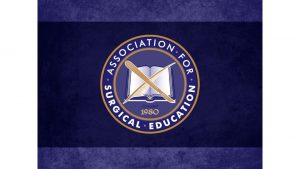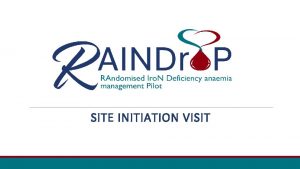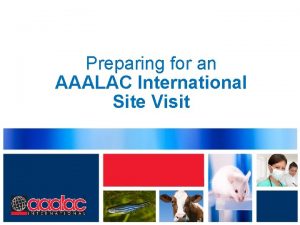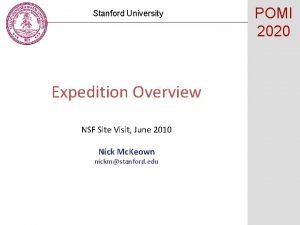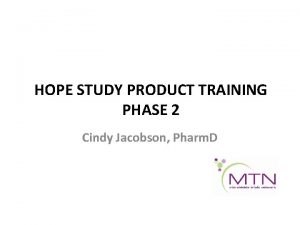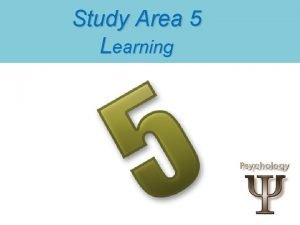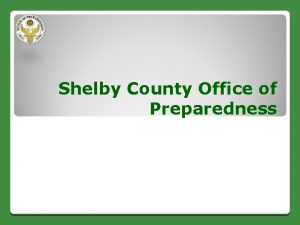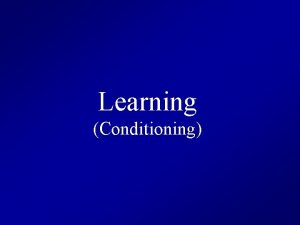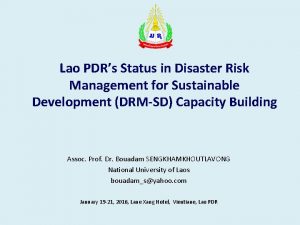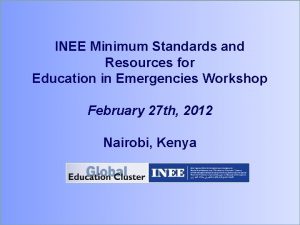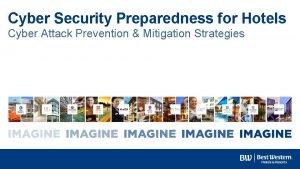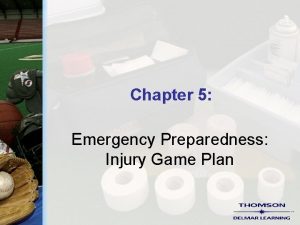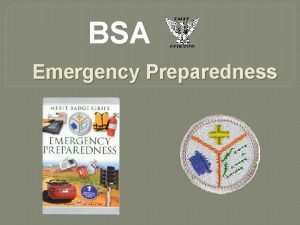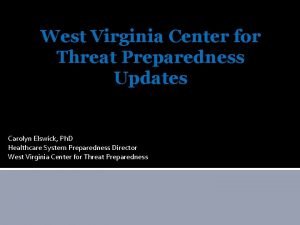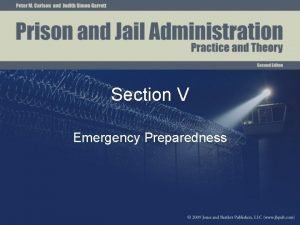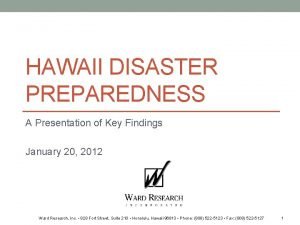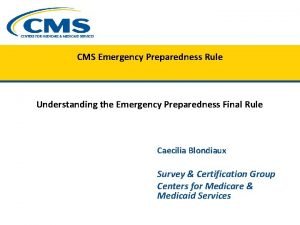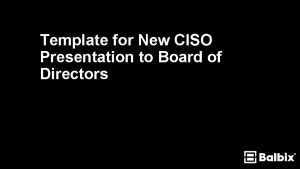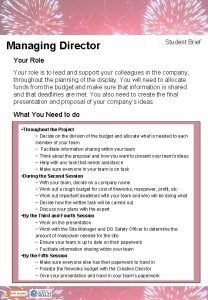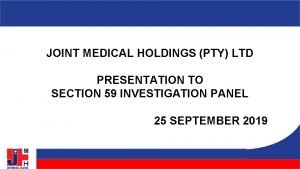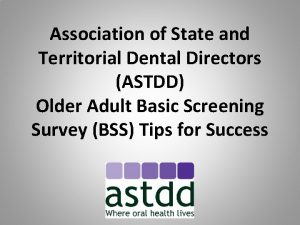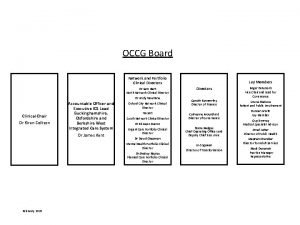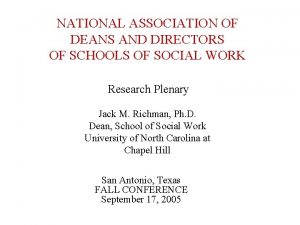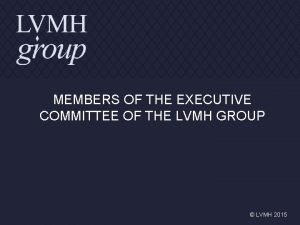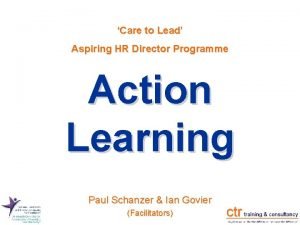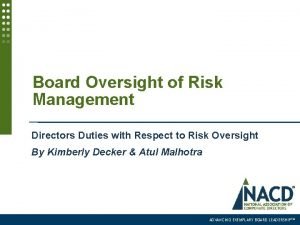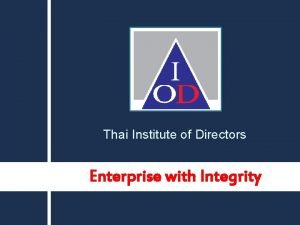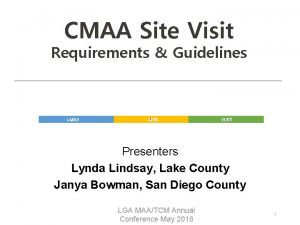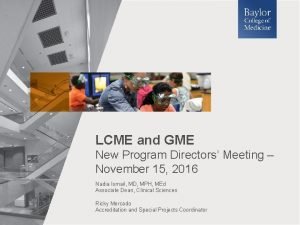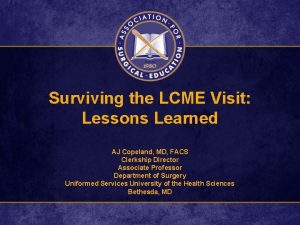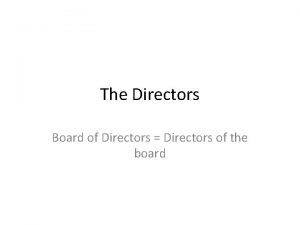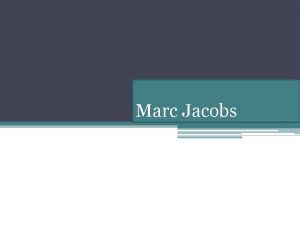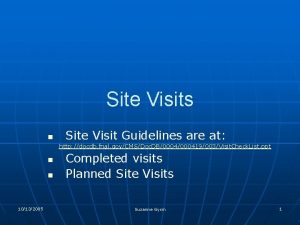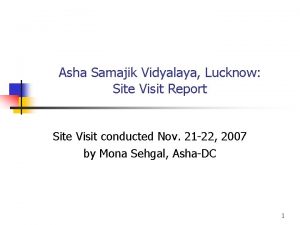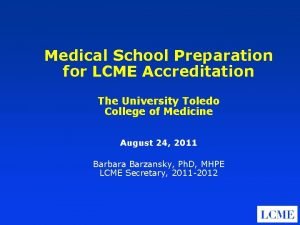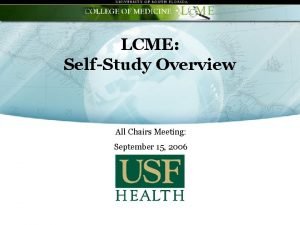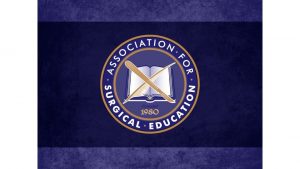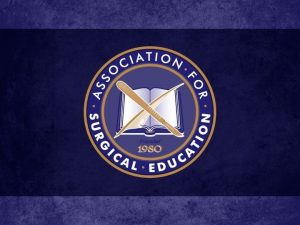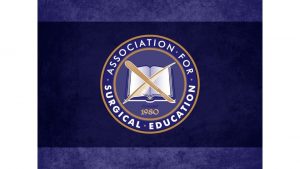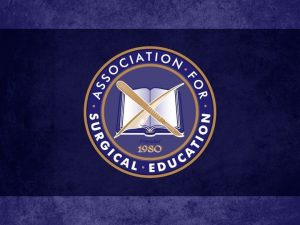LCME Site Visit Preparedness for Course Directors Marc













































- Slides: 45

LCME Site. Visit Preparedness for Course Directors: Marc Zumberg American Society of Hematology Course Directors Breakfast December 2015

Show of hands • Who is currently involved in preparation for a LCME site visit? • Who has been through a visit in the last 5 years?


Overview

Timeline DCI=data collection instrument

Timeline

Timeline

Timeline

Timeline

UF COM LCME Self-Study • Goal: To identify the institution’s strengths, areas for improvement, and strategies to address any concerns • 5 Areas with 128 accreditation standards – – – Institutional Setting Educational Program Medical Students (services and learning environment) Faculty Educational Resources • Began March 2013 – Database draft completed Jan. 2014

AAMC GQ 2014 – scale 1 to 5 UFCOM National Office of the Dean for Curriculum: Responsiveness to student problems 4. 6 3. 9 Office of the Dean for Students: Responsiveness to student problems 4. 7 4. 0 Satisfaction with: Career planning services 4. 4 3. 7 4. 5 4. 1 4. 3 3. 9 Academic counseling 4. 5 3. 9 Personal counseling 4. 6 4. 0 Financial aid services 4. 5 4. 1 Faculty mentoring Programs that promote well being, effective stress management, balanced lifestyle

Challenges and Recommendations for Future Action 1. Information Technology Functionality (e. g. , Wi-Fi). Action: updating hardware and software with HSC and University IT Implement University supported Canvas CMS 2015 -16. 2. Active Learning. variability in the quality of newer active learning methods - inconsistency in course quality. Action: Changes in courses - new course directors, faculty development Year 1 course evaluations increased from 2012 -13 to 2013 -14: overall satisfaction increased from 3. 83 to 4. 42. 3. Clerkship Grade Reporting. Final grades within 6 weeks of end of clerkships. Action: Currently in compliance - continue to monitor closely.

4. Faculty “protected time” for education. Action: Direct support to required clerkship directors, key course and discipline directors, and CLG facilitators. Approximately $35 M distributed to departments based on teaching effort. SADEA when informed of concerns, works with faculty and chairs to resolve issues. 5. Faculty and resident diversity. Action: Dean charged a Diversity Committee to develop recommendations to enhance the recruitment and retention. Success reviewed as part of annual evaluations of department chairs. 6. Student debt. Action: The UFCOM continues to work to limit tuition increases (2014 -15: 0% increase) and student scholarships remain a top three philanthropic goal. 7. Student health insurance. High cost of UF health insurance Action: Students can enroll in non-UF insurance plans and are informed of options including www. healthcare. gov and AMA.

Functions and Structure Guidelines

12 Standards

Standards: example

TIPS for Site Visit • Review self study materials and the following – Medical Curriculum Overview: Central governance: Curriculum Committee https: //oea. sites. medinfo. ufl. edu/files/2010/10/M edical-Education-Program 1. pdf – Medical Education Program Policies and Procedures: https: //osa. sites. medinfo. ufl. edu/files/2014/10/P olicies-and-Procedures-Handbook. pdf

– Florida Department of Education Code of Ethics & Principles of Professional Conduct for the Education Profession (page 26) http: //www. fldoe. org/edstandards/code_of_ethics. asp – COM Strategic Plan: http: //med. ufl. edu/about/administrative-resources/ – UFCOM Conflict of Interest Policy http: //coi. med. ufl. edu/ – UFCOM Statement on Diversity - https: //commain. sites. medinfo. ufl. edu/files/2013/02/Statement_ on_Diversity. pdf

• Do you have enough administrative/staff support? Should be yes – if not let us know – from Deans office and sometimes department (this varies) • What type of work are the staff responsible for? Deans office staff help scheduling, uploading course material, formatting exams, exam scoring and analysis ?

Standards: example

Possible questions • Who is the chief official responsible for the educational programs in the COM? Dean Good • How is faculty teaching effort supported? A. Direct FTE support for course directors, CLG small group leaders and discipline coordinators – • B. Funds allocation model (e. RVU system) with approx. $35 M distributed to departments based on teaching effort - model is formula driven – 3 e. RVUs per contact hour in whole class, lab or small group – 10 e. RVUs per student week in required clinical experiences, 5 e. RVUs per student week in elective clinical experience, 4 e. RVUs for student in research lab fulltime – model applies to all teaching in COM courses – model a modification of State University System Instructor Work Load (IWL)– modified with faculty input

Standards: example

• Give an example of unprofessional student behavior and what was done to correct it? 1. Student was late and missing from required assignment – referred to ASC, required to write a reflective paper and assigned a mentor – depending on the severity and repetitive nature this may documented in the course/clerkship evaluation and MSPE 2. Arrogance and condescending behavior of student to others – counseled and referred for psychological evaluation – mentor and reflective paper – documented in clerkship evaluation

• What happens if you have a lecturer who doesn’t perform well? They are usually counseled by course director for improvement and may be referred to a specific faculty development workshop for remediation– if poor performance persists the CD has authority to replace the faculty • Do you have the authority to remove lecturers? YES • Do you receive sufficient support for being a course director? YES – FTE from Deans office – departments get e. RVUs for faculty teaching effort

• What is the procedure for students who have a concern about their grade? Review Grade grievance policy in Handbook, page 13: First course director, then grievance committee • If a student came to you and wants confidentiality about a sexual assault, what would you do? University policy – tell student if informed you must report to the University per policy

• Is there any central monitoring of student mistreatment? • What is your policy about sexual harassment? • How are courses reviewed? • How often do you get data from student assessments?

Questions: Diversity, Inclusion & Health Equity • What is your schools definition on diversity? “The College is committed to nurturing greater inclusion of African Americans, Hispanics and Native Americans as well as the socioeconomically disadvantaged (rural and urban) as a primary objective for the achievement of excellence through Diversity. The College of Medicine however recognizes that inclusion of other ethnic minorities and groups underrepresented in medicine is essential to the promotion of excellence in healthcare and achievement of health equity for residents in the state of Florida. ”

Standards: example

Possible questions • Are there institutional (or school-wide) objectives? Yes - Approximately 100 linked to the six ACGME competencies • Who is responsible for defining the institutional objectives? Curriculum Committee (CC) • Who is responsible for the overall design, management and evaluation of the curriculum? CC

Possible questions • Who is responsible for approving the objectives in courses and clerkships? CC • Who is responsible for offering admissions to COM? Medical Student Admissions Committee!!!! • Who is responsible for ensuring that students meet the institutional objectives for promotion and graduation? Academic Status Committee – Executive Committee approves graduation based on ASC recommendation

• How do you know if there are gaps or redundancies in the curriculum? National org. recommendations (e. g. , IOM), USMLE content outline, CD discussions, AAMC GQ , performance USMLE, Residency program director surveys, student surveys, search engine, course debriefings

• How does the Curriculum Committee provide oversight to gaps and redundancies in the curriculum? Review student performance USMLE exams, AAMCGQ, Residency Program Director Evaluations, and internal exams including Clinical Skills Exams • How are lecturers evaluated? Student surveys and student performance on exam items – when necessary peer evaluation

• Where is ethics/ebm/others? taught in the curriculum? Longitudinal thread through 4 years – check other topics • How many hours of pre-recorded lectures are students required to watch in a week? 0 -3? ? They are included as a structured learning activity (guideline is max. 25 hrs/wk) • What faculty development have you participated in within the last 2 years? Med Ed week, monthly ed. workshops from Office Faculty Affairs, – others? ? • How do you ensure that students receive mid-course feedback? Quizzes in Phase 1 (first 19 months) of the curriculum

Standards: example

New Curriculum: Fall 2012 3 phase curriculum: ACGME Competency based with ~ 100 Institutional Learning Objectives (developed by faculty) Phase 1: Foundations of Medical Practice (68 weeks, years 1 and 2), integrates clinical skill development and social and behavioral determinants of health with an organ systems model Phase 2: Principles of Medical Practice (48 weeks, year 3), comprises the required clinical clerkships Phase 3: Advanced Medical Practice (36 weeks, year 4), includes electives and capstone clinical experiences (e. g. , Sub. Internship, Anesthesiology-Life Support and Perioperative Medicine, Emergency Medicine, Geriatrics and Rehabilitative Medicine, and Internship 101)

New Curriculum: Implemented Fall 2012 • Patient-centered and integrated (organ system for Phase 1) • Increased collaborative and active learning and interprofessional educational experiences • Longitudinal threads through 4 years (e. g. , evidence based medicine, ethics, patient safety/QI) • Expanded clinical preceptorship(s) Phase 1 • Collaborative learning groups (8 students +1 faculty meet weekly for 2 years during Phase 1, 5 times Phase 2) • 12 week continuity clinic Phase 2, expanded Geriatrics /Rehab Med and Critical Care in Phase 3

Standards: example

• How do you decide what basic science to keep and what should be removed? Use AAMCGQ data, AAMC MSOP, IOM and other reports, USMLE Content Outline and discussions among faculty with recommendations from course and clerkship director committees submitted to CC • What type and how much communication do you have with the clerkship directors? Occurs through participation of Chairs of course and clerkship committees on monthly CC and facilitated by the ADME who is on all 3 committees

• Who has final approval of course content? Course directors and Faculty – must be aligned with course and curriculum objectives (approved by CC) • How do you know what students have been taught prior to your course? Discussions among faculty and Course Dirs. & search engine • How do you use the institutional (school-wide) objectives to guide your content? Course objectives are linked to institutional objectives – learning activities are linked to course objectives and content is linked to learning activity and course objectives

• Provide an example of a linkage between the institutional objective, course objective, and assessment. • How are courses reviewed? Student surveys, student performance data, student/faculty course debriefings, Evaluation Committee and CC review

• Which courses use narrative evaluations? The CLGs provide opportunity for narrative feedback (both oral and written) - CLGs are a learning tool that any course can use for active or engaged learning activities including clinical skills, ICM for history/physical diagnosis- Clinical Skills Exams – others? ? • Do CLG leaders assess students? They provide formative assessment of professionalism, team skills, clinical skills and narrative feedback on student performance in these activities – they do not assign grade – the associated course assigns grades

• How is anatomy integrated within the new curriculum? In ICM with physical examination – coordinated with organ systems • Students noted a dissatisfaction with quality and consistency of the anatomy instruction. What is being done to address their dissatisfaction? This was due to faculty turnover and an unexpected absence of a faculty member for FMLA – faculty has returned and evals. increased • How do you know whether anatomy is successfully covered? USMLE Step 1 scores actually higher, internal exams

• What concerns do you have about the COM or the COM students? • If you had to come up with strengths and areas of improvements, what would they be?

• Be on time TIPS for Site Visit • Be positive (including body language) • Don’t be defensive • Defer question to the person with the most expertise – May be at a different session • Succinctly answer specific question asked • Only provide examples when asked • If you do not understand the question or language; ask the site visitors to re-phrase the question • Review Materials

LCME Attitude
 Lcme clerkship requirements
Lcme clerkship requirements Hot site cold site warm site disaster recovery
Hot site cold site warm site disaster recovery Site initiation visit ppt
Site initiation visit ppt Sop sign off sheet
Sop sign off sheet Aaalac site visit
Aaalac site visit Nsf site visit
Nsf site visit Site visit log
Site visit log Elements of observational learning
Elements of observational learning Shelby county office of preparedness
Shelby county office of preparedness Skinner box
Skinner box Biological preparedness
Biological preparedness Conclusion for disaster preparedness
Conclusion for disaster preparedness Preparedness mitigation response recovery
Preparedness mitigation response recovery Biological preparedness
Biological preparedness Promoting family earthquake preparedness
Promoting family earthquake preparedness Hotel cyber security
Hotel cyber security 1achors
1achors Chapter 5 emergency preparedness injury game plan
Chapter 5 emergency preparedness injury game plan Chapter 36 emergency preparedness and protective practices
Chapter 36 emergency preparedness and protective practices Bsa emergency preparedness
Bsa emergency preparedness West virginia center for threat preparedness
West virginia center for threat preparedness National radiological emergency preparedness conference
National radiological emergency preparedness conference Chapter 36 emergency preparedness and protective practices
Chapter 36 emergency preparedness and protective practices Stake emergency preparedness plan
Stake emergency preparedness plan Who pip framework
Who pip framework Implementing nfpa 1600 national preparedness standard
Implementing nfpa 1600 national preparedness standard Hawaii disaster preparedness
Hawaii disaster preparedness Vulnerability disaster management
Vulnerability disaster management Nfpa business continuity
Nfpa business continuity Cms emergency preparedness requirements by provider type
Cms emergency preparedness requirements by provider type Benzene discovery
Benzene discovery Information security presentation to board of directors
Information security presentation to board of directors Namata board of directors
Namata board of directors Directors brief
Directors brief Joint medical holdings
Joint medical holdings Directors emma wolverson
Directors emma wolverson Compliance presentation to board
Compliance presentation to board Board advisory services
Board advisory services Association of state and territorial dental directors
Association of state and territorial dental directors Blade runner german expressionism
Blade runner german expressionism Clinical directors network
Clinical directors network National association of deans and directors
National association of deans and directors Antonio belloni lvmh
Antonio belloni lvmh Aspiring directors programme
Aspiring directors programme Board of directors risk oversight responsibilities
Board of directors risk oversight responsibilities Thai institute of directors association
Thai institute of directors association
